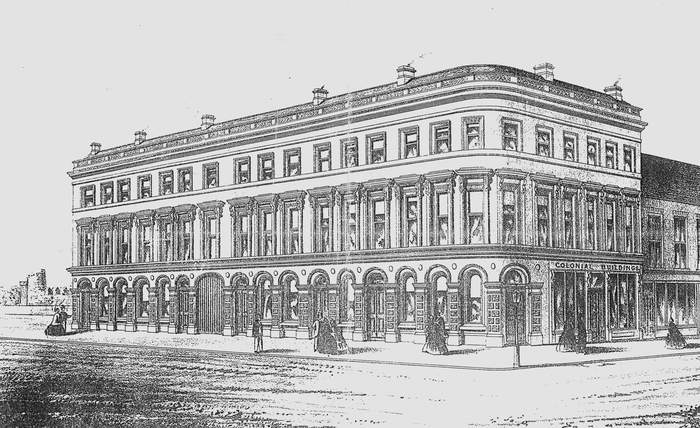“An important structure is now in the course of completion in ‘the citie of the tribes,’ which will supply a decided want in that hitherto neglected town, but destined – we trust at no distant period – to be a great highway from the Old to the New World. Very little indeed has been done in Galway in the way of building improvements, but a wide field is now being opened; and as transatlantic commercial intercourse increases, so must her prosperity and architectural requirements,” so began an exciting article in the Dublin Builder of January 1, 1860.
It continued: “The new institute presents a frontage of about 40 feet by 70 feet flank, each elevation harmonizing in character, and displaying architectural features, with bowed connection between the two fronts. Towards the principal street, on ground floor, is a large business concern, with about 25 feet frontage and 33 feet depth, with central doorway, and also communicating with a small office, a fire-proof safe room, parlour (15 feet square ), pantry, hall, and staircase of a private house. In the basement are various apartments, comprising kitchens, servants’ bedrooms, sculleries, cellars, etc, to meet the requirements of the habitations with which they are in connection. The plans throughout are admirably arranged, and in execution will, no doubt, prove most commodious.
"Externally the elevations consist of three storeys, the lower (or ground ) being a pseudo arcade, with vermiculated piers, impost mouldings, and semi-circular-headed opens, with a bold continuous cornice above, and circular ornaments in spandrels. The fronts are in cement, executed, with the rest of plastering work throughout, by Messrs. Hogan and Son, of Great Brunswick Street, Dublin; and the entire works have been carried out from designs and under the superintendence of Mr. E. H. Carson, architect, Dublin, by Mr. Austin Semple, builder, Galway; Mr. B. Killian, proprietor.”
It was partly erected by Mr B Killian of Galway and when he died, it passed into the hands of Mr William Wright of Dublin who completed it. The cost of the building was £5,000 while it added greatly to the beauty of the town, it also supplied desideration which would have been felt by the inhabitants.
At the lower end completing the building, there were plans for three houses each containing a parlour, drawing room, four good bedrooms, kitchen, pantry and water closet with thorough ventilation and abundance of room and light.

Our drawing was made by Mr Austin Semple, the builder from Galway. It was published in the Dublin Builder on November 1, 1866. Our photograph of Eglinton Street façade was taken just a few years later, and it would seem the plan for at least one house at the end was abandoned as it was taken over by the Cork Tobacco Depot, Clarke & Son, manufacturers. This later became Casey’s Cigar and Wine Store. The photograph was given to us by Chetham Library, Manchester.
The building referred to was known as ‘Colonial Buildings’ on the corner of Williamsgate Street and Eglinton Street. Mr Killian’s business was eventually bought by Francis McNamara and later run by his son John Francis. In 1900, Austin Green bought it out. In 1911, he married a Miss Maxwell and they set up a company which included a branch shop in Longford. Their son Joseph Maxwell Green ran the business until 1928, after which it was run by a company called McNamara Maxwell.

